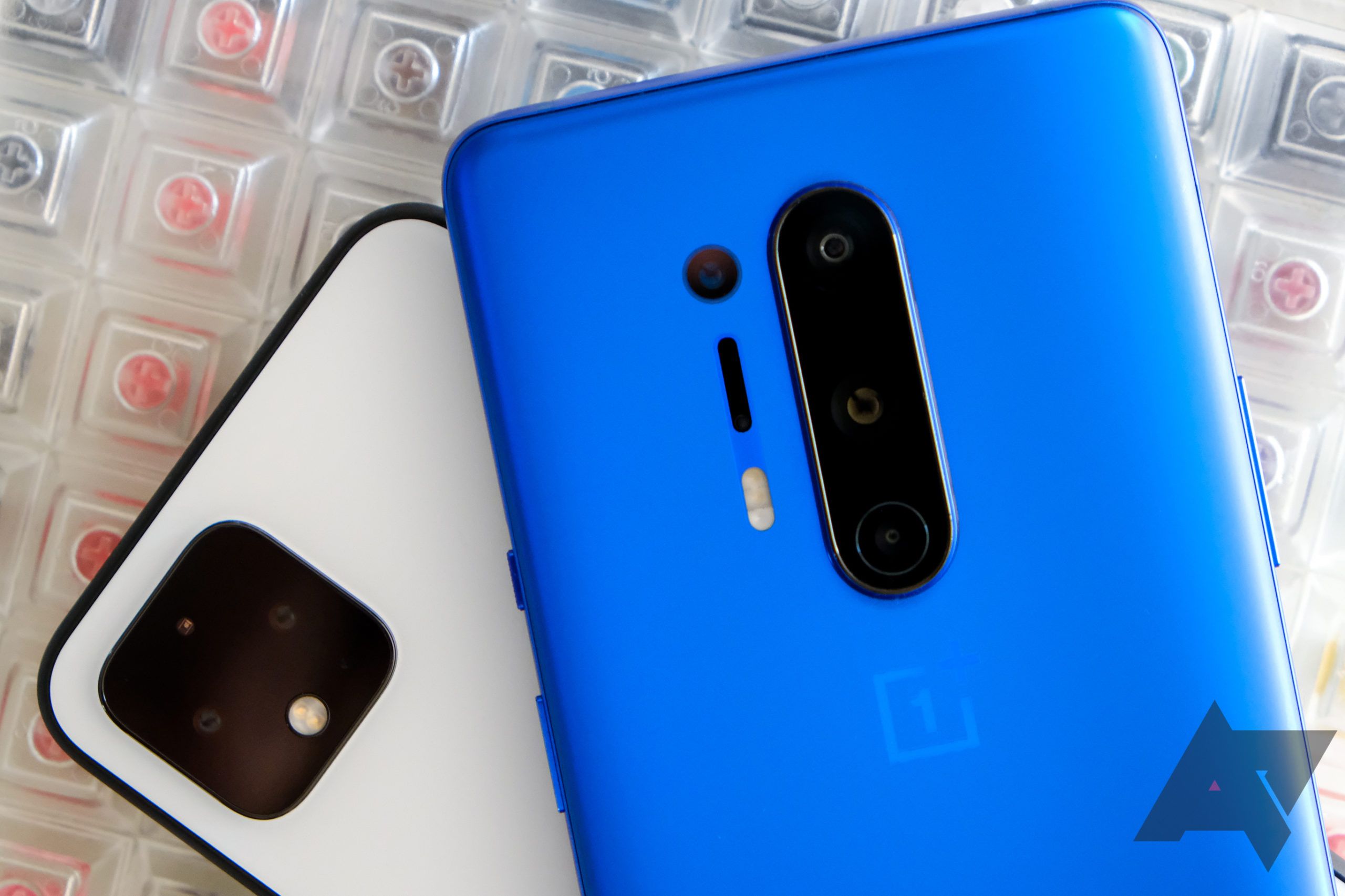The OnePlus 8 Pro is out, and while it's the company's most feature-packed phone yet, it has the price tag to match. Even the cheapest 8 Pro, which comes with 128GB of storage and 8GB RAM, costs a whopping $899. That's several hundred dollars more expensive than the OnePlus 7 Pro and 7T Pro before it.If you value good performance and quick Android updates, the OnePlus 8 Pro and Google's Pixel 4 XL are the top choices right now. But which one should you get? The answer, as you may have guessed, isn't exactly clear-cut.
Hardware
OnePlus has prided itself on producing phones with top-of-the-line hardware for years, while Google's Pixel line has typically lagged behind other flagships. For example, the Pixel 3's meager 4GB RAM was a frequent problem for camera processing and other intensive functions, though the Pixel 4's 6GB of memory largely fixed memory issues.
|
OnePlus 8 Pro |
Pixel 4 XL |
|
|---|---|---|
|
Processor |
Snapdragon 865 |
Snapdragon 855 |
|
Storage |
128GB or 256GB |
64GB or 128GB |
|
RAM |
8GB or 12GB |
6GB |
|
Display |
6.78" 3168x1440 120Hz AMOLED |
6.3" 1440x3040 90Hz AMOLED |
|
Battery |
4,510mAh |
3,700mAh |
|
Rear cameras |
48MP f/1.7 primary |
12.2MP f/1.7 main |
|
Front camera |
16MP f/2.45 (IMX 471) |
8 MP, f/2.0, 22mm |
|
Charging |
30W Warp Charge 30T, 30W Warp Charge Wireless, 15W USB Power Delivery (USB-PD) |
18W USB Power Delivery (USB-PD), 10W wireless charging with Pixel Stand, 5W Qi wireless charging |
|
Headphone jack |
No |
No |
|
Water protection |
IP68 |
IP68 |
|
5G support |
Yes |
No |
|
Dimensions |
165.3mm x 74.35mm x 8.5mm, 199g |
160.4 x 75.1 x 8.2mm, 193g |
The OnePlus 8 Pro is an upgrade from the Pixel 4 XL in almost every regard, at least when it comes to hardware. It has a newer Snapdragon 865 processor (with integrated 5G support), more cameras, a bigger battery, faster charging, and a larger screen with a slightly-higher refresh rate.
OnePlus 8 Pro
However, there are some downsides. For one, the gargantuan size of the OnePlus 8 Pro might not be for everyone. OnePlus also uses a proprietary charging technology, so you'll only hit 30W fast charging when using the company's own wall adapter or wireless charging pad. You can still get up to 15W with a USB Power Delivery (USB-PD) charger, though.
Though the Pixel 4 XL does generally have weaker hardware, it does come out ahead in a few areas. For one, it uses standard USB Power Delivery for fast charging, so you can use a wide range of wall adapters and batteries with it. The camera also performs better than the OP8's in most cases, especially with its Night Sight feature — check out our original review for more details. Finally, the Pixel 4's Soli sensor enables super-quick face unlock and air gestures, though it's not perfect.
Pixel 4 XL
Software
The OnePlus 8 Pro and Pixel 4 XL are a little closer when it comes to the software experience. Both phones don't stray too far from the stock Android experience, but they do add a few nice software tweaks on top.
OnePlus 8 Pro
OnePlus calls its version of Android 'OxygenOS,' and it generally has a greater emphasis on customization. The default home screen launcher has far more options than you would find on the Pixel, more of the interface can be modified, 'quick gestures' can open various apps by swiping in a pattern on the screen, and so on. Check out the software section of our OnePlus 8 Pro review for detailed information.
Pixel 4 XL
The Pixel 4 XL's software experience is lighter on features, but there are more being added all the time, now that Google has started releasing occasional 'Feature Drops.' You can customize the look of the software, change songs and pause playback using air gestures (thanks to the Soli sensor), turn the dark mode on and off automatically based on the time of day, and more.
If security is incredibly important to you, the Pixel 4 has the advantage of receiving Android's monthly security updates quicker than nearly every other phone on the market — including OnePlus devices. Check out our Android security update tracker for the latest information.
Price
Perhaps the most important difference between the OnePlus 8 Pro and Pixel 4 XL is the price. The OP8 Pro starts at $899 for 128GB of storage and 8GB RAM, with the more expensive 12GB RAM/256GB storage option going for $999. Meanwhile, the base Pixel 4 XL with 64GB storage and 6GB RAM is just 9.
Conclusion
The decision about which phone you should get isn't quite cut-and-dry: the OnePlus 8 Pro isn't an upgrade from the Pixel 4 XL in every regard, and even if it was, the $300 price difference still means buying a Pixel might be the better choice for some folks.
If you absolutely have to have the best performance, largest screen, and fastest charging, the OnePlus 8 Pro won't disappoint. However, the Pixel 4 XL offers a very similar experience for a whopping $300 less. The 90Hz screen is still smoother than most other phones on the market (though not quite as fluid as the OP8 Pro's 120Hz display), performance is still very good, and the camera actually beats OnePlus' phones in some areas.
Ultimately, the OnePlus 8 Pro is the king of hardware in 2020, but the Pixel 4 XL is still a great choice at the current reduced price.
Where to buy the OnePlus 8 Pro
Note: If you use our referral link when buying from the OnePlus store, you can get $10 off accessories.
Where to buy the Pixel 4 XL

